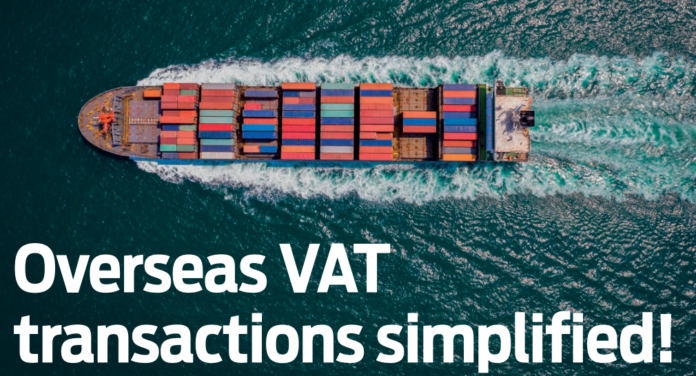June 2021
In the latest in his ‘Keep it Simple’ series, Neil Da Costa tackles the dreaded topic of VAT on overseas transactions. With the UK leaving the EU, this is a topic expected to feature in the forthcoming tax exams.
Exports of goods before Brexit
Exports are zero-rated, which means that as the goods are leaving the UK there is no output VAT payable. However, they are taxable supplies, and an export company is still permitted to claim back input VAT on the UK purchases.
Sales to EU customers before Brexit were called dispatches, and the only sales subject to 20% VAT were to a non-VAT registered person within the EU. Any sales outside the EU were zero-rated regardless of the customer being VAT registered.
Imports of goods before Brexit
Imports from an EU supplier were called acquisitions in the UK and no VAT was payable.
However, the UK company was required to account for both input and output VAT in the same quarter. This was called the EU reverse charge.
Imports from outside the EU were called third country imports and input VAT was payable at 20% once the goods arrived in the UK. As the UK business is VAT registered, this input VAT could be claimed back. To avoid cash flow problems, the company was allowed to postpone the payment of VAT until the 15th of the following month under the deferment scheme.
Simple Example: British Bikes Ltd
British Bikes Ltd is VAT registered and has the following information (VAT exclusive) for 1.1.20 – 31.3.20. All sales are to non-VAT registered persons.
UK customer sales £100,000, French customer sales £100,000, Australian customer sales £100,000.
UK purchases £50,000, German parts £20,000, Taiwan parts £20,000.
Solution To Simple Example: British Bikes Ltd
Output VAT is payable on both the UK and French customer sales (£200,000 x 20% = £40,000). The sales to Australian customers were zero-rated.
The company can claim back input VAT on its UK purchases (£50,000 x 20% = £10,000).
The German parts would result in a reverse charge of £20,000 x 20% = £4,000 treated as both input and output VAT.
The Taiwan parts would also result in input VAT of £4,000 which can be claimed back.
This means that the total output VAT will be £40,000 + £4000 = £44,000
The total input VAT will be £10,000 + £4,000 + 4,000 = £18,000.
The VAT payable is £44,000 – £18,000 = £26,000.
Exports and imports of goods after Brexit (1/1/2021 onwards) Sales to EU customers after Brexit are now identical to sales outside the EU and all exports are zero-rated. All imports are subject to VAT at 20% which can be claimed back under the deferment scheme.
Simple Example: British Bikes Ltd
British Bikes Ltd is VAT registered and has the following information (VAT exclusive) for 1.1.21– 31.3.21. All sales are to non-VAT registered persons.
UK customer sales £100,000, French customer sales £100,000, Australian customer sales £100,000.
UK purchases £50,000, German parts £20,000, Taiwan parts £20,000.
Solution To Simple Example: British Bikes Ltd
Output VAT is payable on only the UK customer sales (£100,000 x 20% = £20,000) The sales to French and Australian customers are zero-rated.
The company can claim back input VAT on its UK purchases (£50,000 x 20% = £10,000).
The German and Taiwan parts would result in input VAT of £40,000 x 20% = £8,000 which can be claimed back.
This means that the total output VAT will be £20,000.
The total input VAT will be £10,000 + £8,000 = £18,000.
The VAT payable is £20,000 – £18,000 = £2,000.
Trade And Cooperation Agreement (TCA)
Just before Brexit, the UK agreed a free trade agreement with the EU which means goods can move freely in both directions without tariffs and will not be restricted by quotas. To comply with the TCA, the goods must originate in the UK and EU.
Simple Example: British Bikes Ltd
British Bikes would not satisfy the origin test as it uses parts from Taiwan. As a result, the sales to French customers may attract tariffs and would instead come under the WTO Most Favoured Nation (MFN) rules. This could make the bikes more expensive.
Services to overseas customers
B2B sales are taxed in the customer’s country and result in the service reverse charge. B2C sales will be taxed in the seller’s country.
• Neil Da Costa is a Senior Tax Lecturer with Kaplan in London. He believes in keeping things simple and making tax fun




